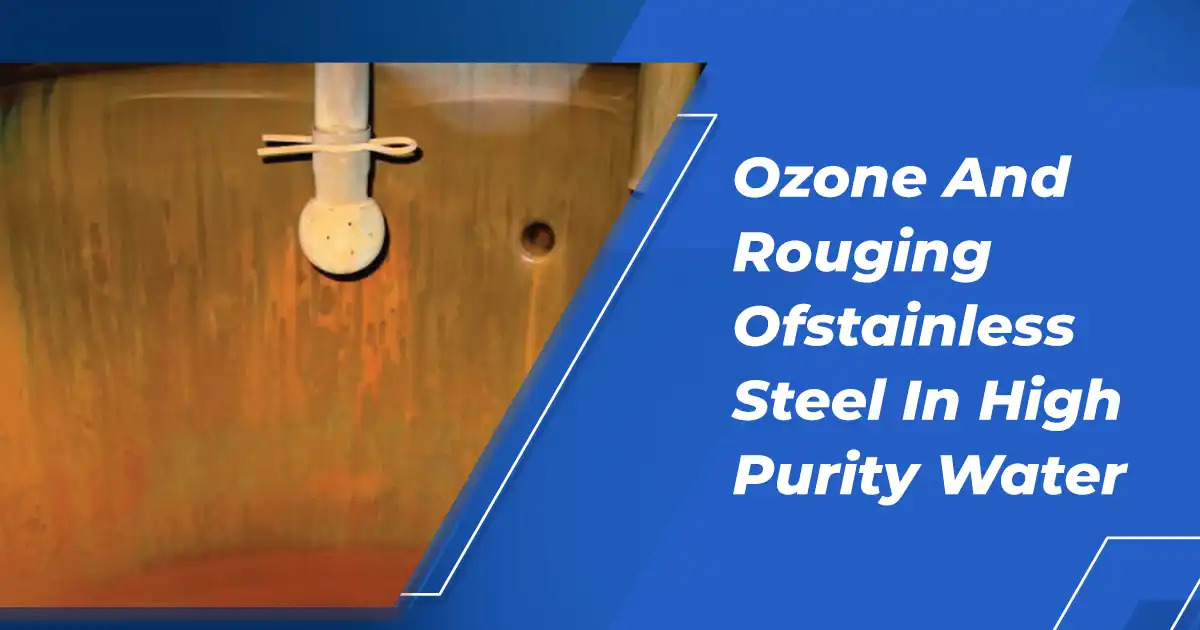Ozone And Rouging Ofstainless Steel In High Purity Water
Posted on: March 18, 2022

The most preferred MOC for water ozonation is SS 316 . All wet parts of the water treatment system in contact with ozone are recommended to be of SS 316 . The difference between SS 304 and SS 316 is the increased content of nickel ( above 10% ) and Molybdenum ( above 2% ) . The presence of molybdenum makes the SS resistant to corrosion of any sort and therefore very stable with Ozone
However it may be noted that in few ozone installations ( especially in pure water ) , precipitate are seen during ozone. They following are observed
- Yellow/brown staining inside SS316L Tank and pump.
- Slight increase in conductivity post Ozonation
- Very little or no staining post UV destruction
To understand the cause of these precipitates we need to understand that SS , whether it is 304 or 306 contains iron as Carbon steel ( combination with carbon ) and the proportion can be as high as 70% . The alloys formed by the combination of nickel, chromium, Molybdenum makes what stainless is . These alloys passivate the surface of the carbon steel to make it corrosion resistant .So presence of precipitates over long use with ozone is no surprise
Typical Combination of SS 316Iron 70%Carbon: 0.08%Silicon: 0.75%Manganese 2%Chromium :16%Nickel: 10%Molybdenum: 2%Phosporous:0.045%Sulphur: 0.03%
Nitrogen: 0.1%
Possible root causes: This phenomenon of formation of iron precipitates in SS 316 after long use with ozone is called Rouging.
Rouging of the SS316 tank and pump is due to surface iron oxidation.Rouging of the SS316 tank can happen because of the following reasons:
- Excess Throttling of pump/cavitation of pump resulting in micro-bubble implosion in the impeller resulting in Chromium, and, iron stripping from the SS316 into the water stream. In pure water streams iron particles can get deposited in the SS316 surface, getting oxidized ( by ozone) over time and giving a yellow-brown stain that can be easily removed by wiping.
- High temperatures during Hot water sanitization can increase occurrence of this process. In the presence of Ozone, oxidation is rapid, while post ozone destruction, it will be much slower
- Contamination of SS316 material during fabrication, storage or from external sources
Pumps – could it be the main cause of rouging ?
Selection of pumps for ozonation is important. All wet parts of the pump, including impeller, inlet and outlet must be of SS 316 . The pump design needs to be such that the pipe sizes prevent cavitation and limited. Formation of micro bubbles need to be minimised. Choice of correct pump will also limit the requirement of throttling of pump valves. we very often see water engineers resorting to throttling of pump valves to wither increase venturi suction or even increase pressure in the pipe lines . Frequent Throttling could cause implosion of micro bubbles on the surface of the SS , release iron content little at a time .The iron precipitates settle on surface of water tanks and these get oxidized by ozone to ferric hydroxide that forms the red precipitates
ROUGHING EXAMPLE IN PUMP HOUSING
Water Based System : When using a water based electrolytic ozone system often there are doubts if iron precipitates formed could be due to suffusing of anode material into the water .This is a rare occurrence and the client could best clarify with the manufacturer of the water based system
Identifying Roughing
- Water Analysis to identify iron content, if any
- No pre ozonation precipitates ( upstream ozone)
- Precipitates formed after 4-5 years of ozonation
- No precipitates downstream UV ozone destruction
- Pumps MOC are all SS 316
Solution: Derouging and re-passivation of SS tanks and pipelines. Replace pumps
1 comment

Shreyas Baratharaj | Director
Sheryas Barathraj has over 15 years of experience in municipal and industrial ozone applications. He has worked on some of the world’s largest ozone installations, with key interests in advanced oxidation, chemical synthesis, pharmaceutical water systems, and municipal drinking water treatment. LinkedIn Bio ›



https://shorturl.fm/B6i1B